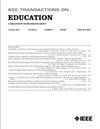Impact of NEWTON Technology-Enhanced Learning Solutions on Knowledge Acquisition in Pilots Involving Students With Hearing Impairments
IF 2
2区 工程技术
Q2 EDUCATION, SCIENTIFIC DISCIPLINES
引用次数: 0
Abstract
Contributions: This article presents the results of a study carried out as part of two large-scale pilots and analyzes the impact of the use of modern technologies in education in term of knowledge acquisition in case of students with hearing disabilities. Background: Teaching topics from STEM area is a challenging task for all teachers who have students with hearing disabilities in their class. On the one hand, because of the high degree of difficulty of the information in this field and on the other hand, because of the difficulties that students with hearing disabilities face in understanding this information. In this context, the use of modern technologies in education, but especially the way they are used together with traditional ones, can provide great support for teachers of students with special needs. Intended Outcomes: A set of modern technologies, i.e., virtual lab, virtual reality (VR), in the game-based learning context of the EU-funded NEWTON project, were employed in education as part of the Earth Course. The goal was to increase the accessibility of STEM information in the area of natural sciences for the benefit of students, especially those with hearing disabilities. Application Design: The study targeted secondary school students with hearing disabilities. Content related to natural sciences (i.e., wildlife and sealife) was presented as part of the Earth Course via innovative applications that included virtual laboratories and VR. Avatars were used to support the students with special needs (sign-language translation). Findings: The results of this study demonstrate that the use of modern technologies, combined with game-based learning in science lessons for students with hearing disabilities, contribute to increasing their knowledge level. The best results were obtained when these technologies were used in mixed lessons, alongside the traditional teaching methods.NEWTON 技术强化学习解决方案对听障学生知识获取试点的影响
贡献:本文介绍了作为两个大型试点项目的一部分而开展的一项研究的结果,并分析了在教育中使用现代技术对听力残疾学生获取知识的影响。研究背景对于班上有听力残疾学生的所有教师来说,STEM 领域的教学课题都是一项具有挑战性的任务。一方面是因为该领域的信息难度很大,另一方面是因为听力残疾学生在理解这些信息时面临困难。在这种情况下,在教育中使用现代技术,特别是将现代技术与传统技术结合起来使用的方式,可以为有特殊需要的学生的教师提供极大的支持。预期成果:在欧盟资助的 NEWTON 项目的游戏式学习背景下,一套现代技术,即虚拟实验室、虚拟现实 (VR),被应用于教育中,作为地球课程的一部分。其目的是提高自然科学领域 STEM 信息的可及性,使学生,尤其是听力有障碍的学生受益。应用设计:研究对象是有听力障碍的中学生。与自然科学(即野生动物和海豹)相关的内容作为地球课程的一部分,通过包括虚拟实验室和 VR 在内的创新应用进行展示。使用头像为有特殊需要的学生提供支持(手语翻译)。研究结果本研究的结果表明,在为听力残疾学生开设的科学课中使用现代技术,结合游戏式学习,有助于提高他们的知识水平。当这些技术与传统教学方法一起在混合课程中使用时,效果最好。
本文章由计算机程序翻译,如有差异,请以英文原文为准。
求助全文
约1分钟内获得全文
求助全文
来源期刊

IEEE Transactions on Education
工程技术-工程:电子与电气
CiteScore
5.80
自引率
7.70%
发文量
90
审稿时长
1 months
期刊介绍:
The IEEE Transactions on Education (ToE) publishes significant and original scholarly contributions to education in electrical and electronics engineering, computer engineering, computer science, and other fields within the scope of interest of IEEE. Contributions must address discovery, integration, and/or application of knowledge in education in these fields. Articles must support contributions and assertions with compelling evidence and provide explicit, transparent descriptions of the processes through which the evidence is collected, analyzed, and interpreted. While characteristics of compelling evidence cannot be described to address every conceivable situation, generally assessment of the work being reported must go beyond student self-report and attitudinal data.
 求助内容:
求助内容: 应助结果提醒方式:
应助结果提醒方式:


